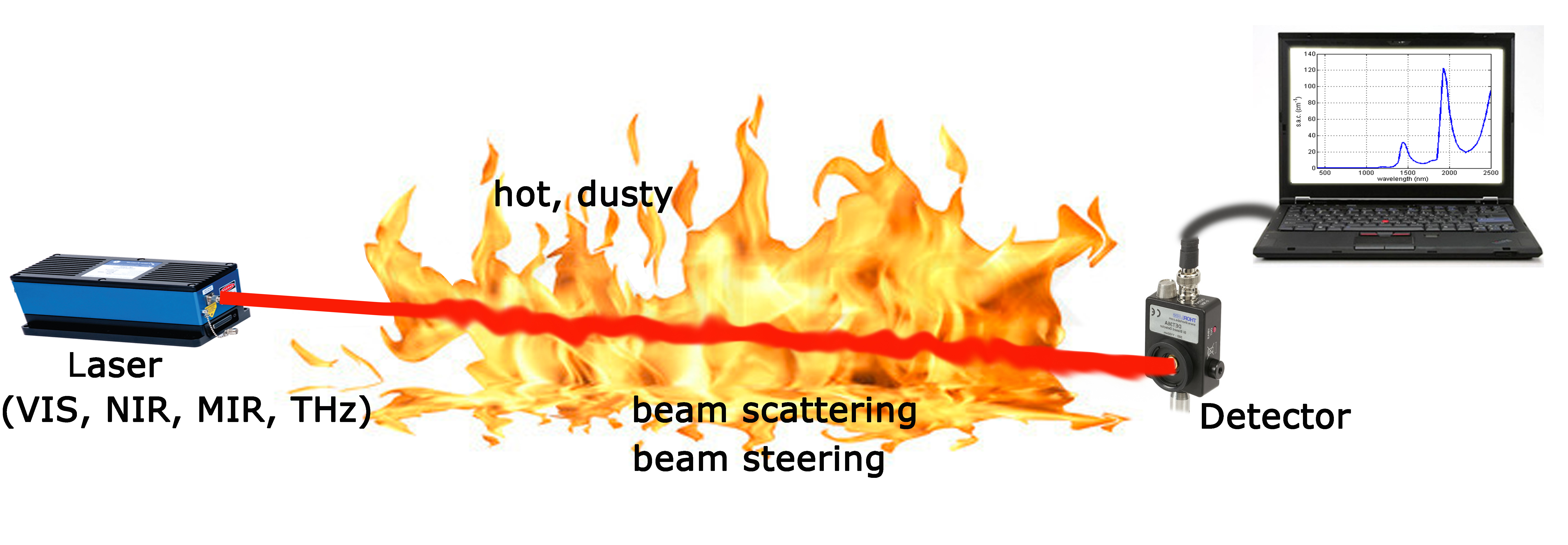
This program focuses on developing optical sensors to measure gas composition, temperature, and flow rate in furnaces, which usually have a harsh environment with high temperatures and high dust levels. The real-time measurements are feed into process models and are finally used to optimize the process control and thus to save energy and reduce environment pollution. These sensors are based on the absorption and emission spectroscopy in the UV, VIS, NIR, MIR, and THz regions. We are currently working on the following three projects.
1) Transmission of laser beam through a dusty and high temperature environment
Since most of gases have absorption spectrum fingerprints, tunable diode laser (TDL) is widely used to sample them. However, it is found that the laser beam does not penetrate through the hot and dusty fume gases, which is caused by the beam scattering of the dust particles and the beam steering effect due to the temperature gradient and turbulence. The purpose of this project is to further understand why the light is distinguished and then to find out a solution. The beam scattering test is carried out in the lab by making the light of different wavelengths (VIS, NIR, MIR) go through a dusty environment. The experimental results are compared with the Mie scattering model. The beam steering experiment is done by making the laser beam propagate through a high temperature vertical flow reactor (VFR) and a methane flame, respectively.
2) Design of a terahertz system to measure CO and H2O concentrations.
Lasers in the visible and mid-infrared ranges have run into significant practical problems in trying to penetrate the particle-laden off-gas of a furnace. Light scattering is caused by micron-sized particles present at high densities. According to the Mie-scattering theory, the transmittance (I/Io) of a light beam increases with the wavelength of the laser. Therefore light with large wavelengths (i.e. low frequencies) should pass through the particles with less scattering. The terahertz region of the spectrum (100 µm to 1 mm) holds significant promise in penetrating particle-laden gas streams. This project will apply and extend recent developments with terahertz lasers in our area of interest: in situ techniques to measure gas composition and temperature in the off-gas of an industrial furnace. The traditional advantages of absorption spectroscopy will continue to apply in the case of terahertz: the theory behind the measurement is well known (Beer’s Law for composition and absorption peak ratios for temperature). Currently, we are concentrating on the measurement of H2O and CO. The experimental results are compared with the HITRAN simulation.
3) Development of a remote sensor for measurement of metallic compositions by measurement of light emissions at high temperature.
Monitoring the metallic composition change in a hot furnace in real time is very important in industry. However, the current technique needs proper maintenance and thus increases the operation cost. Since the metallic components have radiation “signatures” emitted at high temperatures, we aim to develop a passive optical sensor system to monitor the light emission and thus calculate the concentrations. We employ an optical head to collect the light from a safe distance, which minimizes the maintenance cost. We also develop an algorithm for qualitative and quantitative measurements.



